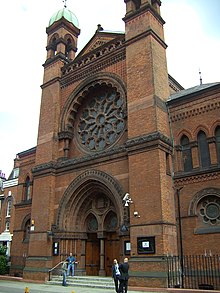New West End Synagogue
| New West End Synagogue | |
|---|---|

New West End Synagogue façade from St. Petersburgh Place
|
|
| Basic information | |
| Location |
St. Petersburgh Place |
| Affiliation | Orthodox Judaism |
| Municipality | London |
| District | Bayswater |
| Country | United Kingdom |
| Year consecrated | 1879 |
| Status | Active |
| Heritage designation | National monument, Grade I listed |
| Website | www |
| Architectural description | |
| Architect(s) | George Ashdown Audsley |
| Completed | 1879 |
| Capacity | 800 |
St. Petersburgh Place
London, W2
United Kingdom
The New West End Synagogue, located in St. Petersburgh Place, Bayswater, London, is one of the oldest synagogues in the United Kingdom still in use. It is one of two synagogues which have been awarded Grade I listed status by the British government, and has been described by Historic England as "the architectural high-water mark of Anglo-Jewish architecture". It can accommodate approximately 800 people.
Services are held everyday: Sunday Shacharit - 8:30 Weekday Shacharit - 7:00 Friday Evening Mincha & Ma'ariv - on commencement of the Sabbath Shabbat & Yom Tov Shacharit - 9:15
Designed by George Audsley of Scotland in collaboration with Nathan S. Joseph, its foundation stone was laid on 7 June 1877 by Leopold de Rothschild in the presence of the Chief Rabbi, Dr. Nathan Marcus Adler, and the building was formally opened on 30 March 1879.
Chaim Weizmann, the first president of the State of Israel, and Herbert Samuel, the British High Commissioner for Palestine during the British Mandate, were both members of the synagogue. Their seats are marked with plaques. The synagogue's first rabbi was Simeon Singer, who translated and edited the Authorized Daily Prayer Book, which is still used in Orthodox synagogues across Great Britain.
Perhaps the most famous rabbi of New West End Synagogue was Louis Jacobs, whose ties with the synagogue were severed in what became known as the Jacobs affair, and went on to found the Masorti movement.
...
Wikipedia
